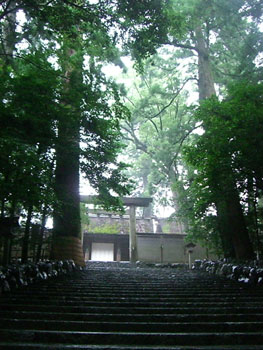No.2 New Year's Pilgrimage
 Traditionally, Japanese people visit their local shrines and temples on new year's day to give thanks for the previous year and wish for happiness, health and success in the coming year. If you have lived or visited Japan during the new year's season, there is no doubt you witnessed the masses of people who flock to shrines and temples in a flurry of activity and celebration as they say goodbye to the old and welcome the new.
Traditionally, Japanese people visit their local shrines and temples on new year's day to give thanks for the previous year and wish for happiness, health and success in the coming year. If you have lived or visited Japan during the new year's season, there is no doubt you witnessed the masses of people who flock to shrines and temples in a flurry of activity and celebration as they say goodbye to the old and welcome the new.
Tucked within the southeast part of Ise City lies Ise Jingu, the most sacred of all Shinto shrines in Japan. Within Ise Jingu, Amaterasu Ohmikami, is enshrined. She is the sun goddess and one of the principal Shinto gods or Japanese “kami”. Her name, Amaterasu, loosely translates into English as “the god that lights the world from heaven”. Amaterasu Ohmikami is the most respected god for the Japanese people and is still believed by some to be in direct lineage to the Japanese royal family. In many ways, the history of Ise Jingu is the history of Japan. It is long, rich and filled with tradition.
An unforgettable and truly Japanese experience awaits any visitor to Ise Jingu during the new year’s holiday since each year, approximately one half a million people visit Ise in order to pay their respects at Jingu. If you are one for crowds or being in the middle of the action, then Ise City is the place for you. Besides the serene beauty and nature that surrounds Ise Jingu, the Okageyokocho and Oharai Street areas near the entrance to Ise Jingu are filled with shops, restaurants and museums to satisfy almost any visitor.
However, one does not have to be a student of Japanese history or folklore to enjoy the splendor of Ise Jingu throughout the year since Ise Jingu is open every day of the year. I personally love to visit when it is very quiet—usually at dawn. Visitors can normally enter the shrine area at first light or soon after. I feel early morning is the best time since visitors can enjoy walking through the beautiful gardens and forest and connect to the divine no matter what religion they may or may not have. (The picture above was taken on an early morning last July. No one was around at that time—a somewhat rare occurrence for Jingu!). I have often heard it said by visitors to Ise Jingu that they cannot put their finger on just what is so special about it however, they all agree, IT IS an extraordinary place.
Things will begin to quiet down this week and even more so in the few remaining days of January. After that, I plan to begin my usual visits to Ise Jingu again to find the peace and serenity that only Jingu can offer. Please check back in a few weeks and I will post more about one of my favorite places in Ise! For more information about Ise Jingu, please click this link.
